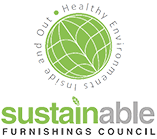
But how can companies do this, especially when supply chains are long and complex? The best way to avoid the “bad” is to proactively source the “good” by adopting and implementing a responsible wood sourcing policy (see below) – working with suppliers to establish with the greatest degree of certainty possible that wood comes from responsible sources. (This is also the most effective way to exercise “due care” or “due diligence” regarding high risk sources under the US Lacey Act. This act establishes criminal and civil penalties for American companies that are caught trading in illegal wood. Click here to learn more about the Lacey Act and risk management.)
What do we mean by responsible sources? The most obvious example is using wood that is recycled (convert waste into reusable material), reclaimed (recover material for reuse), or salvaged (retrieve or preserve something from potential loss) – wood that might otherwise go to waste. However, the supply of wood from such sources is limited.
In the end, all wood comes from trees that must be harvested from forests or plantations, and these can be managed more or less responsibly. Responsible forestry preserves or restores the health and integrity of forest ecosystems. It minimizes the use of chemicals and preserves the natural fertility of the soil, protecting against erosion and maintaining the quality of streams and rivers. It conserves wildlife habitat and biodiversity. There’s an important human dimension as well: truly responsible forestry upholds the well-being of forest-dependent communities and respects the rights of indigenous peoples. Companies and consumers can support responsible forestry by “voting with their dollars” and buying products certified under a credible forest certification system, such as the Forest Stewardship Council (FSC).
Forest Certification
Forest certification is a voluntary, market-based tool to promote responsible forestry. The independent certification and eco-labeling of forestry and forest products came into being in the early 1990s, inspired by the success of organic agricultural and concern about high rates of deforestation. At the foundation of forest certification are standards covering the social as well as environmental aspects of responsible forest management.
There are a variety of forest certification systems to choose from. While any of them is better than nothing, the Sustainable Furnishings Council, National Wildlife Federation and most other environmental groups believe that the most credible system is that of the FSC. FSC’s standards are the most robust and the only ones developed by a true diversity of economic, social and environmental stakeholders.
FSC certification for responsible forest management is provided through a system of independent, annual on-site audits. Manufacturers who process certified wood, and traders who bring it to market, are certified for Chain of Custody, to ensure the products retain their integrity throughout the supply chain. Retailers obtain an FSC trademark license to credibly promote FSC certified products. And finally, consumers look for the FSC labels on products to identify those which support responsible forest management.
Wood Sourcing Policies
A responsible wood sourcing policy is much more than a statement of good intentions; it is a formal commitment to take action and a framework for guiding decisions and gauging progress. A robust policy defines the activities that must be undertaken to deliver on the company’s objectives related to responsible sourcing, establishing what is and is not acceptable to personnel responsible for procurement.
Responsible wood sourcing policies are especially effective when combined with goal setting and public reporting of progress against those goals. For instance, a company that adopts a policy that states two goals (a: to gradually increase purchases of FSC-certified and recycled/reclaimed wood, and b: to avoid illegal wood), might set a 3-year goal of 25% of overall wood purchases for the former and 100% for the latter. Reporting progress annually against those goals will increase staff motivation and ensure both public and internal accountability. As we all know, “What gets measured gets managed!”
Download Sample Policy
Download a document containing a simple example of a responsible wood sourcing policy by clicking the button below:
Sample Responsible Wood Sourcing Policy
Resources
There are several organizations that have expertise in supporting companies interested in developing and implementing responsible wood sourcing policies, including:









